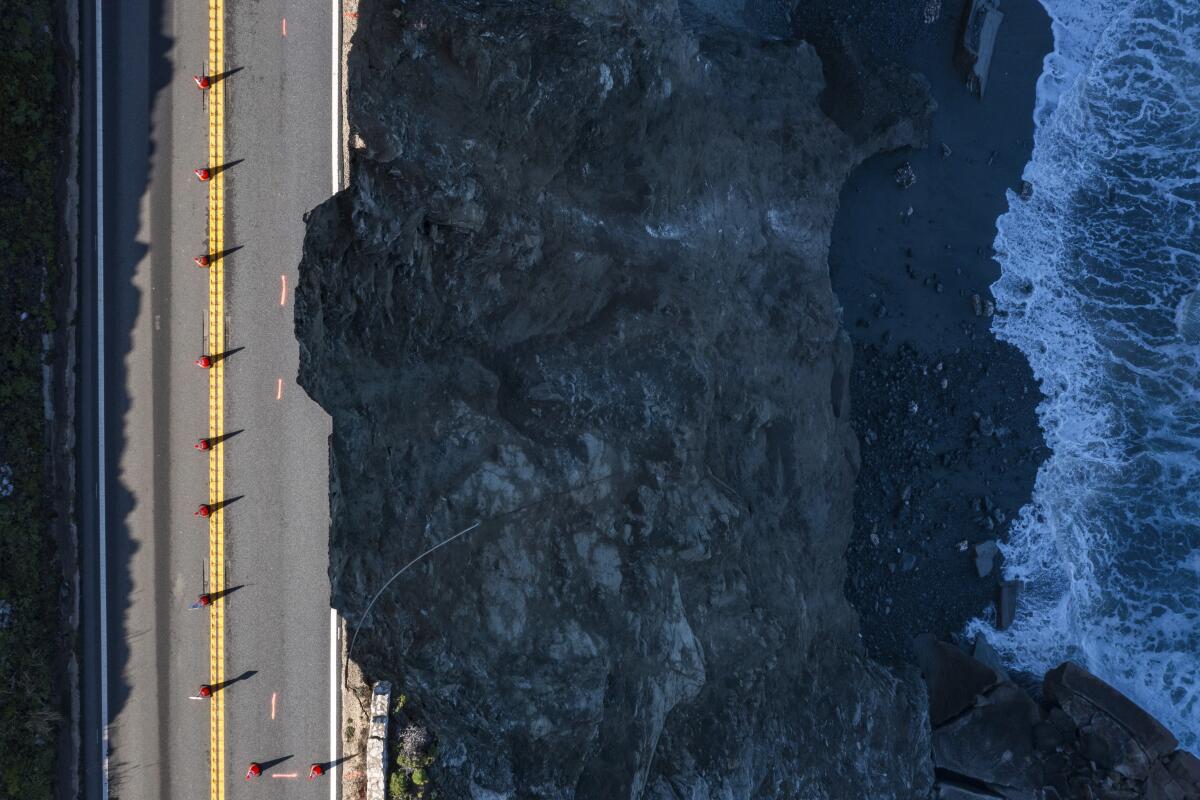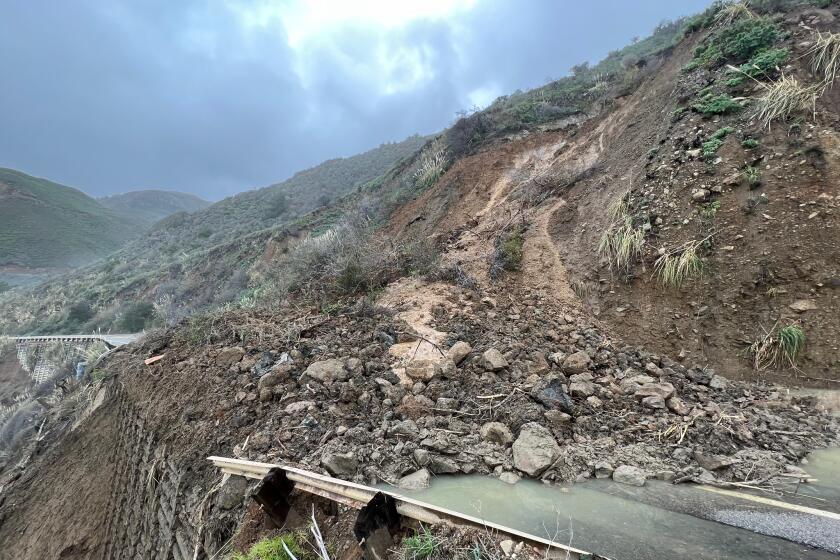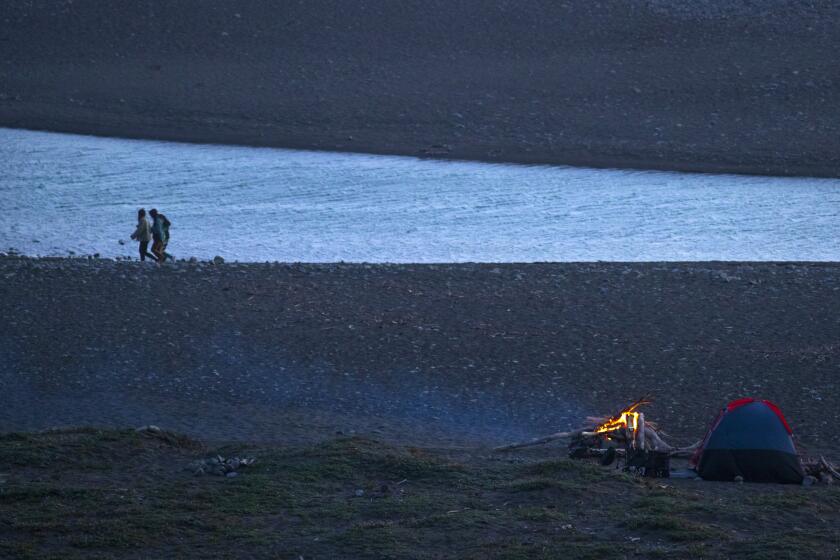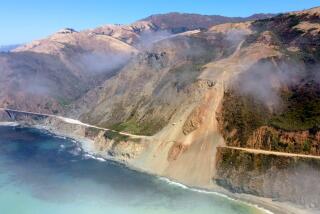Big Sur tourism ‘on standstill’ after its connecting roadway crumbles into the sea -- again

- Share via
Tourists and locals alike found themselves stranded overnight in Big Sur on Easter weekend after Caltrans shut down a portion of Highway 1 that was falling into the ocean.
It was merely the latest time that the outdoor tourist hot spot was nearly cut off from the outside world.
Officials discovered a slip-out on the southbound lane early Saturday evening and quickly closed the road to further vehicle travel to assess damage. With the 1.4-mile stretch shut down, there were no other exit roads and about 1,600 people were forced to seek accommodations for the night.
Day tripper Eric Adams, a hobbyist landscape photographer and resident of Monterey County, unexpectedly found himself having to sleep in his car.
“There were a few moments of people being a little distressed by the prospect of an extended stay without accommodation for food,” Adams said. But the following Sunday morning, Caltrans deemed the northbound lane safe enough to travel and began escorting people out in caravans at the hours of 8 a.m. and 4 p.m.
“In general everyone was very friendly and making the best of a bad situation,” Adams said.
Highway 1 is closed indefinitely from Palo Colorado Road to Rocky Creek Bridge, the California Department of Transportation said on social media after a new landslide eroded part of the roadway.
The storm that arrived on Saturday didn’t bring especially strong downpours, said Diana Ballantyne, general manager of Big Sur’s Fernwood Resort.
But the afternoon closure of Highway 1 at Rocky Creek Bridge — on a critical stretch connecting Big Sur with Carmel-by-the-Sea — caught visitors and businesses by surprise.
“We had hundreds of people with no place to go on Saturday,” said Ballantyne, who described selling supplies and blankets to some visitors who had driven down for the day and were forced to sleep in their cars overnight. “The restaurant and grocery store were extremely busy.”
On Sunday, motels like Fernwood were busy trying to manage the chaos, and when they got news that Caltrans was going to lead traffic across the bridge, there was a mass exodus.
“It’s pretty quiet today,” said Ballantyne, who has been busy canceling reservations for this week, which because of spring break was especially busy.
“I’ve been living here for 30 years,” she said, “and every natural disaster is a new challenge. We make our decisions on the fly and try to find out the best way to survive the disaster.”
Overuse and abuse by visitors lead Coastal Commission to ban campers from San Carpoforo Beach, the only free camping site in Big Sur, for two years.
Ballantyne is hoping the closure will be no more than two weeks.
“We’re optimistic about this one,” she said. “They’re allowing caravans of locals and vendors with no weigh limit, which tells us that the northbound lane is stable. We’re hoping they’re going to get stoplights up and one-way traffic open very soon.”
Caltrans District 5 posted on social media that the southbound lane between Palo Colorado Road and Rocky Creek Bridge has been indefinitely closed to the public and only essential workers and residents are being allowed through.
California State Parks also announced that some parks would be closed to camping and day use for the coming week. Brent Marshall, the Monterey district superintendent of California State Parks, said officials would reassess day use and reservations after the expected rainy weather this weekend.
“People really love Big Sur and people travel from all over the world,” Marshall said. Even with the limited highway access, he is hopeful that they might be able to reopen sooner than later. “We want to make it as available as possible as long as it’s safe.”
This weekend, officials are planning to install a 500-foot concrete barrier down the center line of the road to make an isolated channel for motorists, according to Kevin Drabinski, spokesperson for Caltrans District 5. “It’s too early to have an estimate for a timeline [of repairs],” Drabinski said. “The first steps that we’re taking will be to stabilize the edge of the roadway in order to facilitate this work.”
But the isolation of Big Sur ended at noon Sunday when Caltrans opened the highway and the northbound lanes.
“Sunday let off all the pressure,” Drabinski said. “Anyone caught unexpectedly on the wrong side of the slide was able to get where they needed to go.”
Engineers assessing the slide have determined that at this point the movement of the earth under the road is “static,” said Drabinski, which means that the convoys — for locals and essential services — will continue.
But that will change, he added, if there is a forecast of rain.
Eventually one-way traffic, coordinated by traffic lights to the north and the south, will allow normal vehicle traffic to proceed on the northbound lanes and “an adequate shoulder,” Drabinski said.
The picturesque yet precarious roadway faced other challenges last month when heavy rains set off a huge landslide about four miles north of Lucia and the New Camaldoli Hermitage. Just over a month later, Caltrans has finalized a repair plan that still needs to undergo an approval process, which will take an additional 30 days.
In the meantime locals are left to manage with the disarray that has come with the latest road failure.
“This puts Big Sur tourism on standstill,” said David Eaks, the front desk supervisor at the Big Sur Lodge. The day of the road closures, Eaks said, they were fully booked with more than 150 people staying in their rooms and taking shelter in their common areas. But now that only locals are allowed through, peak season for camping has come to an abrupt halt.
Deliveries, trash service and mail are still coming through at the moment. But Eaks isn’t so eager to test the weakened roadway. “I’m not risking it,” he said. “I’d rather be stranded on this side, where I live.”
Drabinski said it’s not easy managing a road that was first built in the 1930s. “It’s a geologically active range of mountains, things are always moving around there,” he said. It doesn’t help, he said, that the “rain will make the ground heavier and lubricated” on steep slopes.
Though Adams was pleased overall with officials jumping into action, he thinks there needs to be a more long-term solution.
“There needs to be another access point,” said Adams, who visits Big Sur at least once a week to take photos of the pristine wilderness. “You can’t have thousands of people go into one high-risk area without a way out if something happens, because these landslides keep happening all the time.”
More to Read
Sign up for Essential California
The most important California stories and recommendations in your inbox every morning.
You may occasionally receive promotional content from the Los Angeles Times.














